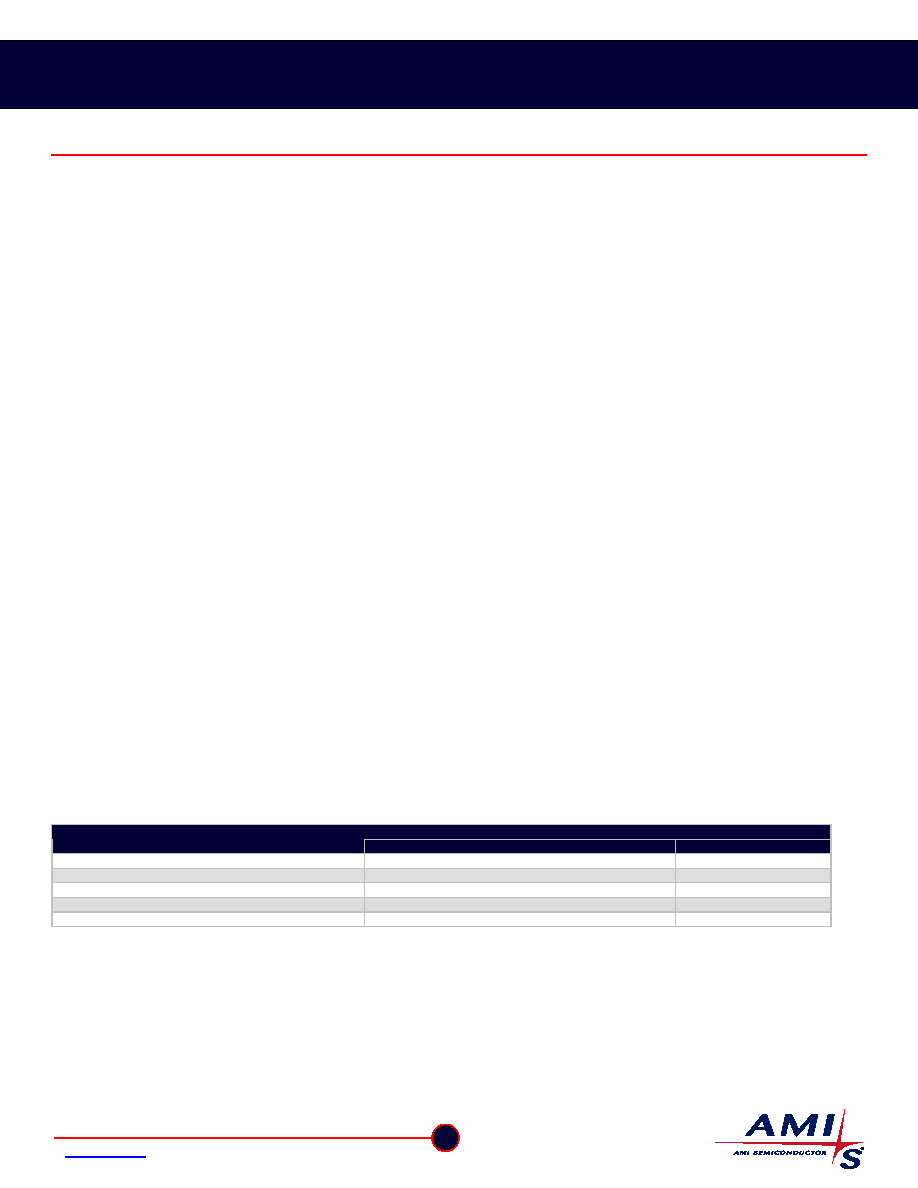- 您現(xiàn)在的位置:買賣IC網(wǎng) > PDF目錄23096 > 0ICAA-001-XTP DATACOM, INTERFACE CIRCUIT, PDSO8 PDF資料下載
參數(shù)資料
| 型號: | 0ICAA-001-XTP |
| 元件分類: | 網(wǎng)絡(luò)接口 |
| 英文描述: | DATACOM, INTERFACE CIRCUIT, PDSO8 |
| 封裝: | 0.150 INCH, GREEN, PLASTIC, SOIC-8 |
| 文件頁數(shù): | 3/12頁 |
| 文件大小: | 560K |
| 代理商: | 0ICAA-001-XTP |

AMIS-42675 High-Speed Low Power CAN Transceiver
Data Sheet
For Long Networks
10.0 Soldering
10.1 Introduction to Soldering Surface Mount Packages
This text gives a very brief insight to a complex technology. A more in-depth account of soldering ICs can be found in the AMIS “Data
Handbook IC26; Integrated Circuit Packages” (document order number 9398 652 90011). There is no soldering method that is ideal for
all surface mount IC packages. Wave soldering is not always suitable for surface mount ICs, or for printed-circuit boards (PCBs) with
high population densities. In these situations re-flow soldering is often used.
10.2 Re-flow Soldering
Re-flow soldering requires solder paste (a suspension of fine solder particles, flux and binding agent) to be applied to the PCB by
screen printing, stencilling or pressure-syringe dispensing before package placement. Several methods exist for re-flowing; for
example, infrared/convection heating in a conveyor type oven. Throughput times (preheating, soldering and cooling) vary between 100
and 200 seconds depending on heating method. Typical re-flow peak temperatures range from 215 to 250°C. The top-surface
temperature of the packages should preferably be kept below 230°C.
10.3 Wave Soldering
Conventional single wave soldering is not recommended for surface mount devices (SMDs) or PCBs with a high component density, as
solder bridging and non-wetting can present major problems. To overcome these problems the double-wave soldering method was
specifically developed. If wave soldering is used the following conditions must be observed for optimal results:
Use a double-wave soldering method comprising a turbulent wave with high upward pressure followed by a smooth laminar wave.
For packages with leads on two sides and a pitch (e):
Larger than or equal to 1.27mm, the footprint longitudinal axis is preferred to be parallel to the transport direction of
the PCB;
Smaller than 1.27mm, the footprint longitudinal axis must be parallel to the transport direction of the PCB. The
footprint must incorporate solder thieves at the downstream end.
For packages with leads on four sides, the footprint must be placed at a 45 angle to the transport direction of the PCB. The footprint
must incorporate solder thieves downstream and at the side corners.
During placement and before soldering, the package must be fixed with a droplet of adhesive. The adhesive can be applied by screen
printing, pin transfer or syringe dispensing. The package can be soldered after the adhesive is cured. Typical dwell time is four seconds
at 250°C. A mildly-activated flux will eliminate the need for removal of corrosive residues in most applications.
10.4 Manual Soldering
Fix the component by first soldering two diagonally-opposite end leads. Use a low voltage (24V or less) soldering iron applied to the flat
part of the lead. Contact time must be limited to 10 seconds at up to 300°C. When using a dedicated tool, all other leads can be
soldered in one operation within two to five seconds between 270 and 320°C.
Table 9: Soldering Method
Soldering Method
Package
Wave
Re-flow
(1)
BGA, SQFP
Not suitable
Suitable
HLQFP, HSQFP, HSOP, HTSSOP, SMS
Not suitable
(2)
Suitable
PLCC
(3) , SO, SOJ
Suitable
LQFP, QFP, TQFP
Not recommended
(3)(4)
Suitable
SSOP, TSSOP, VSO
Not recommended
(5)
Suitable
Notes:
1.
All surface mount (SMD) packages are moisture sensitive. Depending upon the moisture content, the maximum temperature (with respect to time) and body size of the
package, there is a risk that internal or external package cracks may occur due to vaporization of the moisture in them (the so called popcorn effect). For details, refer to
the Drypack information in the Data Handbook IC26; Integrated Circuit Packages; Section: Packing Methods.
2.
These packages are not suitable for wave soldering as a solder joint between the PCB and heatsink (at bottom version) can not be achieved, and as solder may stick to
the heatsink (on top version).
3.
If wave soldering is considered, then the package must be placed at a 45° angle to the solder wave direction. The package footprint must incorporate solder thieves
downstream and at the side corners.
4.
Wave soldering is only suitable for LQFP, TQFP and QFP packages with a pitch (e) equal to or larger than 0.8mm; it is definitely not suitable for packages with a pitch
(e) equal to or smaller than 0.65mm.
5.
Wave soldering is only suitable for SSOP and TSSOP packages with a pitch (e) equal to or larger than 0.65mm; it is definitely not suitable for packages with a pitch (e)
equal to or smaller than 0.5mm.
11
AMI Semiconductor
–October 07, Rev. 1.0
www.amis.com
Specifications subject to change without notice
相關(guān)PDF資料 |
PDF描述 |
|---|---|
| 0ICAA-001-XTD | DATACOM, INTERFACE CIRCUIT, PDSO8 |
| 0ICAA-001-XTP | DATACOM, INTERFACE CIRCUIT, PDSO8 |
| 050-000-1854100 | RF Coaxial Connectors |
| 0ICAB-001-XTD | DATACOM, INTERFACE CIRCUIT, PDSO8 |
| 0ICAB-001-XTP | DATACOM, INTERFACE CIRCUIT, PDSO8 |
相關(guān)代理商/技術(shù)參數(shù) |
參數(shù)描述 |
|---|---|
| 0ICAB-001-XTD | 制造商:AMI 制造商全稱:AMI 功能描述:High-Speed CAN Transceiver |
| 0ICAB-001-XTP | 制造商:AMI 制造商全稱:AMI 功能描述:High-Speed CAN Transceiver |
| 0ICAG-001-XTD | 制造商:AMI 制造商全稱:AMI 功能描述:High Speed CAN Transceiver |
| 0ICAG-001-XTP | 制造商:AMI 制造商全稱:AMI 功能描述:High Speed CAN Transceiver |
| 0ICAH-002-XTD | 制造商:AMI 制造商全稱:AMI 功能描述:High-Speed CAN Transceiver |
發(fā)布緊急采購,3分鐘左右您將得到回復(fù)。